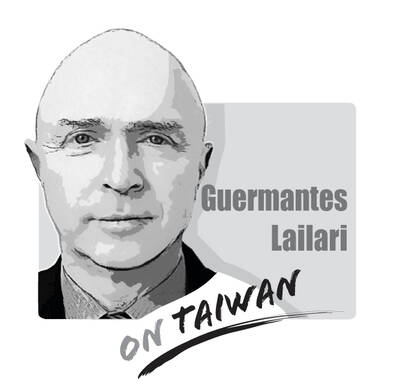It is a shame that the Chinese Nationalist Party (KMT) government has to wait until a small number of racist residents complain about dark-skinned foreigners before officials see the light and “decide to support the arts.”
The two would not seem to have anything to do with one another, but in a country where the absurd is witnessed on a daily basis — this is an independent nation with a president and a military, but many people consider it a province of China — it looks like xenophobia will lead to a cultural flowering at the Taipei Railway Station.
The Ministry of Transportation and Communications and the Ministry of Culture have decided to transform the cavernous lobby of Taipei Railway Station into a temporary stage for young dancers, saying they are doing so to give young people a cultural space to express themselves.
This would be great if it did not come shortly after the Taiwan Railways Administration (TRA) started roping off certain areas of the lobby on Fridays, Saturdays and Sundays after the Muslim holiday Eid al-Fitr brought too many dark-skinned Southeast Asians, as well as people from countries like India and Pakistan, who came to celebrate their holiday in a peaceful way.
Apparently, some Taiwanese commuters unaccustomed to multiculturalism — the kind of people with whom Norwegian mass murderer Anders Behring Breivik would see eye to eye — complained that the crowds of foreigners made them feel unsafe.
In a typical overreaction, the TRA cordoned off what had been one of the few public gathering spaces for Southeast Asians in Taipei, and its announcement later of the dance venue, although on the surface a good thing, simply highlighted that foreign workers are not welcome.
The timing of these two ministries’ plan to promote the arts is suspicious. When has the Ministry of Culture ever been in a hurry to promote culture? More often than not, art venues in the country, such as the Huashan Creative Park and Treasure Hill Artist Community in Taipei, are utterly stripped of all free artistic expression as soon as the government gets involved. There never seems to be budgets available anywhere for painters, musicians, performers, actors, movie producers, or anything artistic, unless their art can become commercially viable in the short term. The Ministry of Culture has proven time and again that it does not support the arts.
So why the sudden change of heart and at a time when so many other cases of racial discrimination are surfacing around the country?
In Taoyuan County, a group of 30 Filipino workers are being forced to move out by next week because residents deem them to be a danger to the community.
In Taipei’s Shida area, police harass Westerners in the park at night even if they are quiet, while ignoring groups of Taiwanese, simply because of what one police officer said was a negative report in a local newspaper about Westerners “picking up drunk women” in the park.
Where will this end? Will Southeast Asians be welcome anywhere? Will foreigners someday be told to stay indoors after an 8pm curfew, while they are herded into foreigners-only dormitories and given no public space at all?
Taiwan, the open, welcome nation that it is, should not allow the forces of xenophobia to take control, because if it does, it will close itself off voluntarily from the rest of the region and the world.

Chinese state-owned companies COSCO Shipping Corporation and China Merchants have a 30 percent stake in Kaohsiung Port’s Kao Ming Container Terminal (Terminal No. 6) and COSCO leases Berths 65 and 66. It is extremely dangerous to allow Chinese companies or state-owned companies to operate critical infrastructure. Deterrence theorists are familiar with the concepts of deterrence “by punishment” and “by denial.” Deterrence by punishment threatens an aggressor with prohibitive costs (like retaliation or sanctions) that outweigh the benefits of their action, while deterrence by denial aims to make an attack so difficult that it becomes pointless. Elbridge Colby, currently serving as the Under
The Ministry of the Interior on Thursday last week said it ordered Internet service providers to block access to Chinese social media platform Xiaohongshu (小紅書, also known as RedNote in English) for a year, citing security risks and more than 1,700 alleged fraud cases on the platform since last year. The order took effect immediately, abruptly affecting more than 3 million users in Taiwan, and sparked discussions among politicians, online influencers and the public. The platform is often described as China’s version of Instagram or Pinterest, combining visual social media with e-commerce, and its users are predominantly young urban women,
Most Hong Kongers ignored the elections for its Legislative Council (LegCo) in 2021 and did so once again on Sunday. Unlike in 2021, moderate democrats who pledged their allegiance to Beijing were absent from the ballots this year. The electoral system overhaul is apparent revenge by Beijing for the democracy movement. On Sunday, the Hong Kong “patriots-only” election of the LegCo had a record-low turnout in the five geographical constituencies, with only 1.3 million people casting their ballots on the only seats that most Hong Kongers are eligible to vote for. Blank and invalid votes were up 50 percent from the previous
Japanese Prime Minister Sanae Takaichi lit a fuse the moment she declared that trouble for Taiwan means trouble for Japan. Beijing roared, Tokyo braced and like a plot twist nobody expected that early in the story, US President Donald Trump suddenly picked up the phone to talk to her. For a man who normally prefers to keep Asia guessing, the move itself was striking. What followed was even more intriguing. No one outside the room knows the exact phrasing, the tone or the diplomatic eyebrow raises exchanged, but the broad takeaway circulating among people familiar with the call was this: Trump did